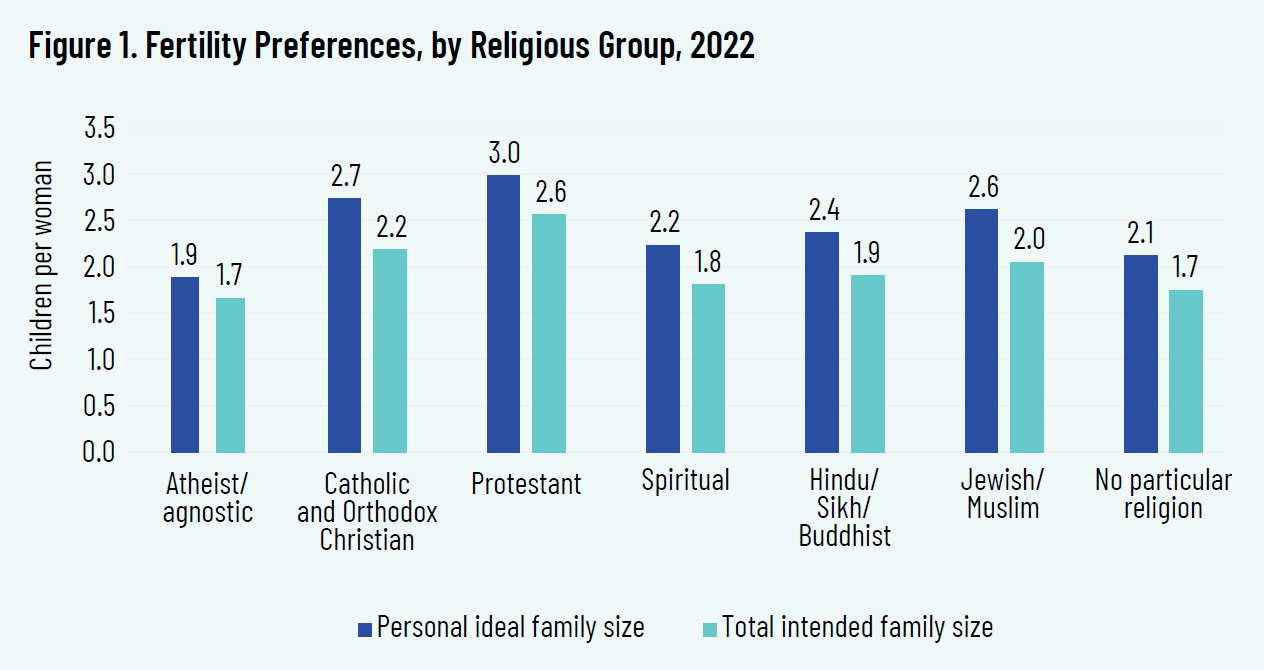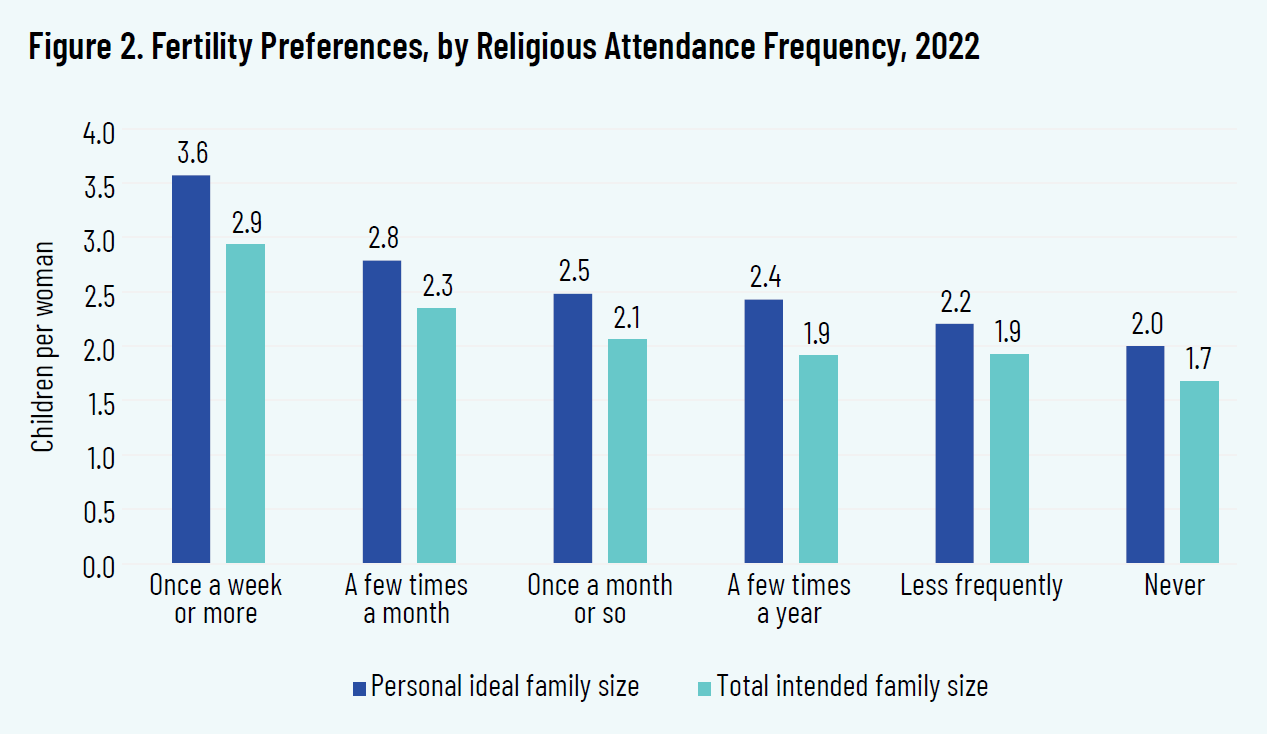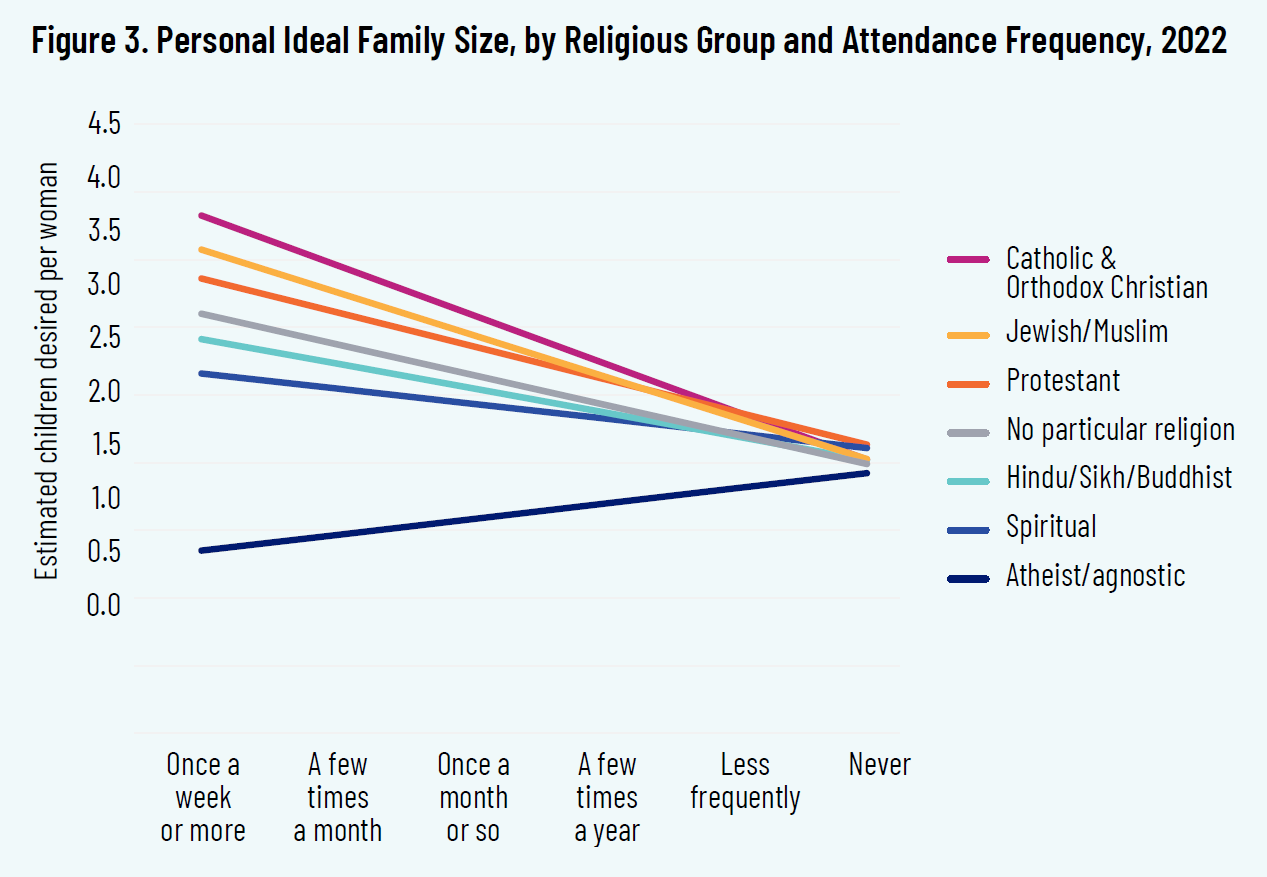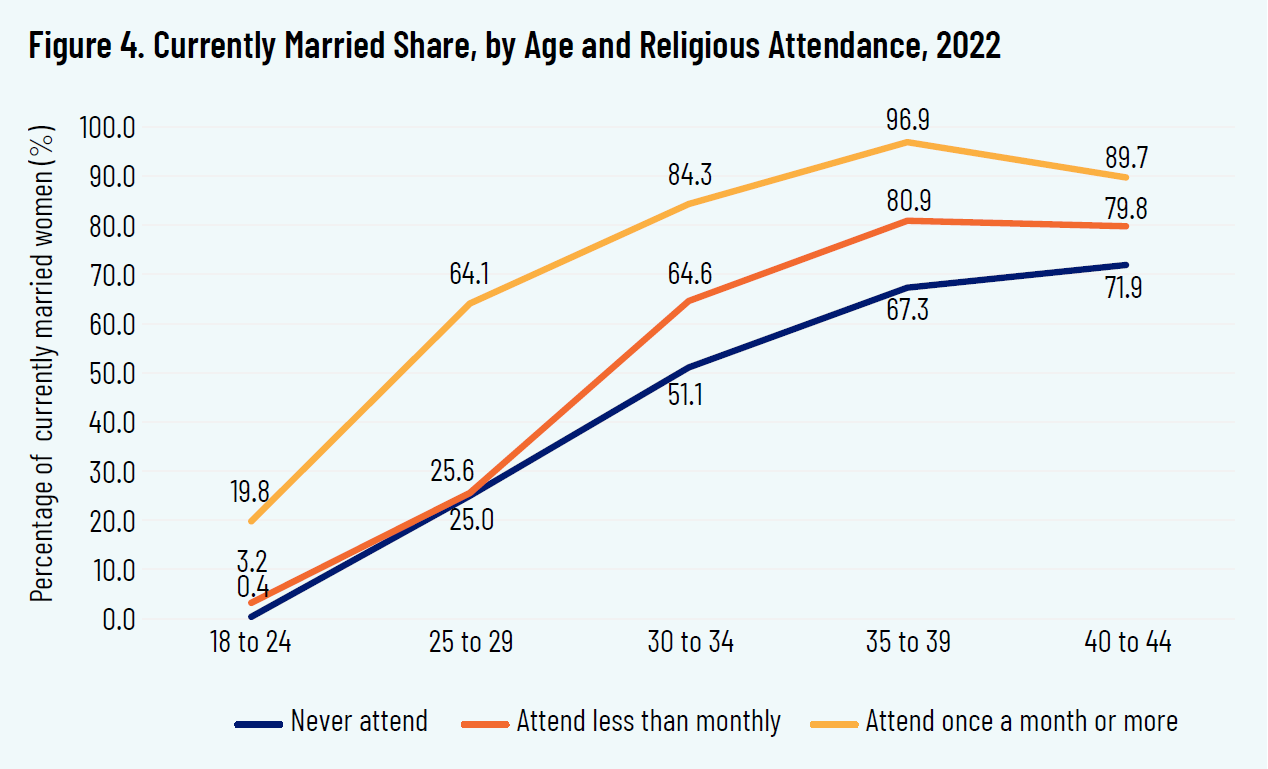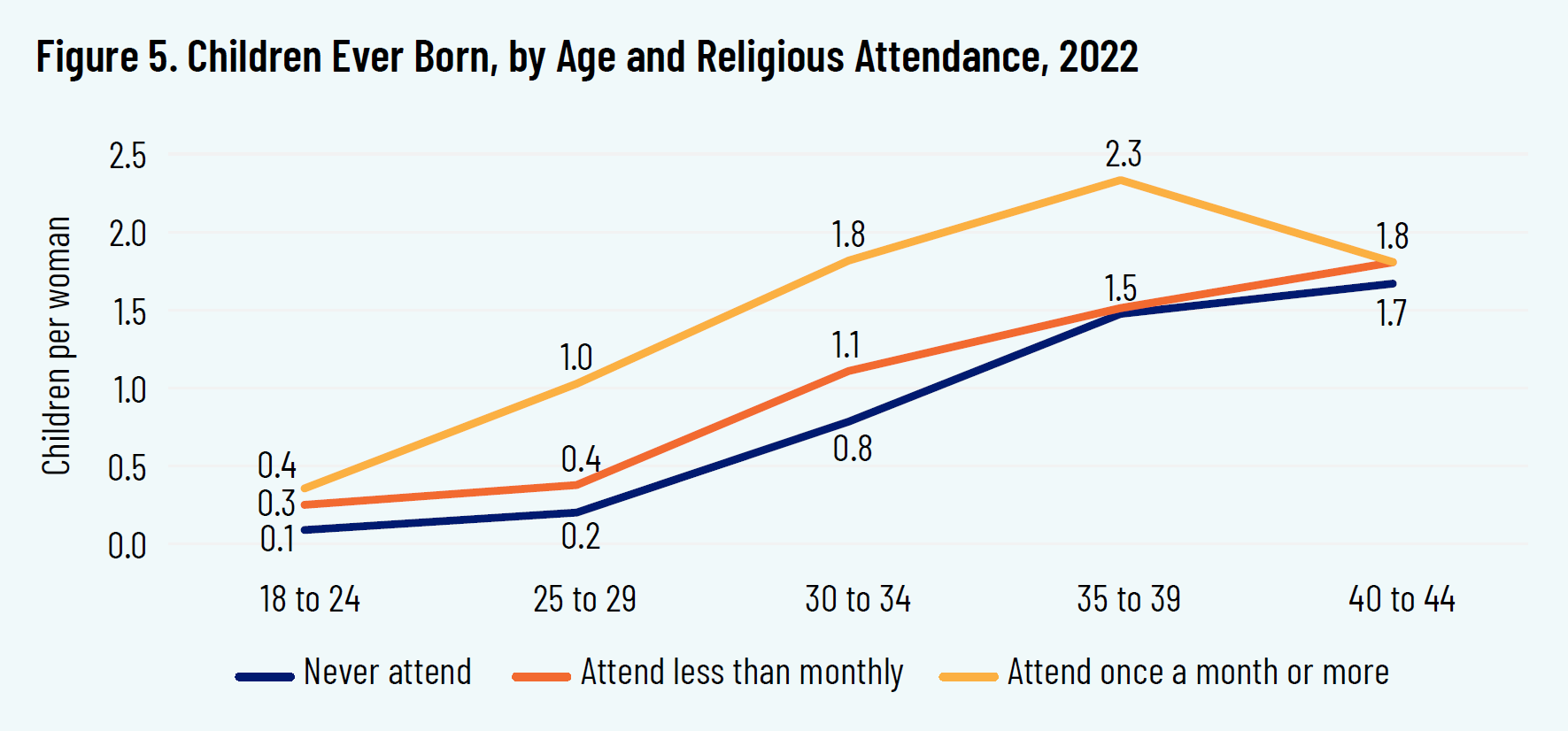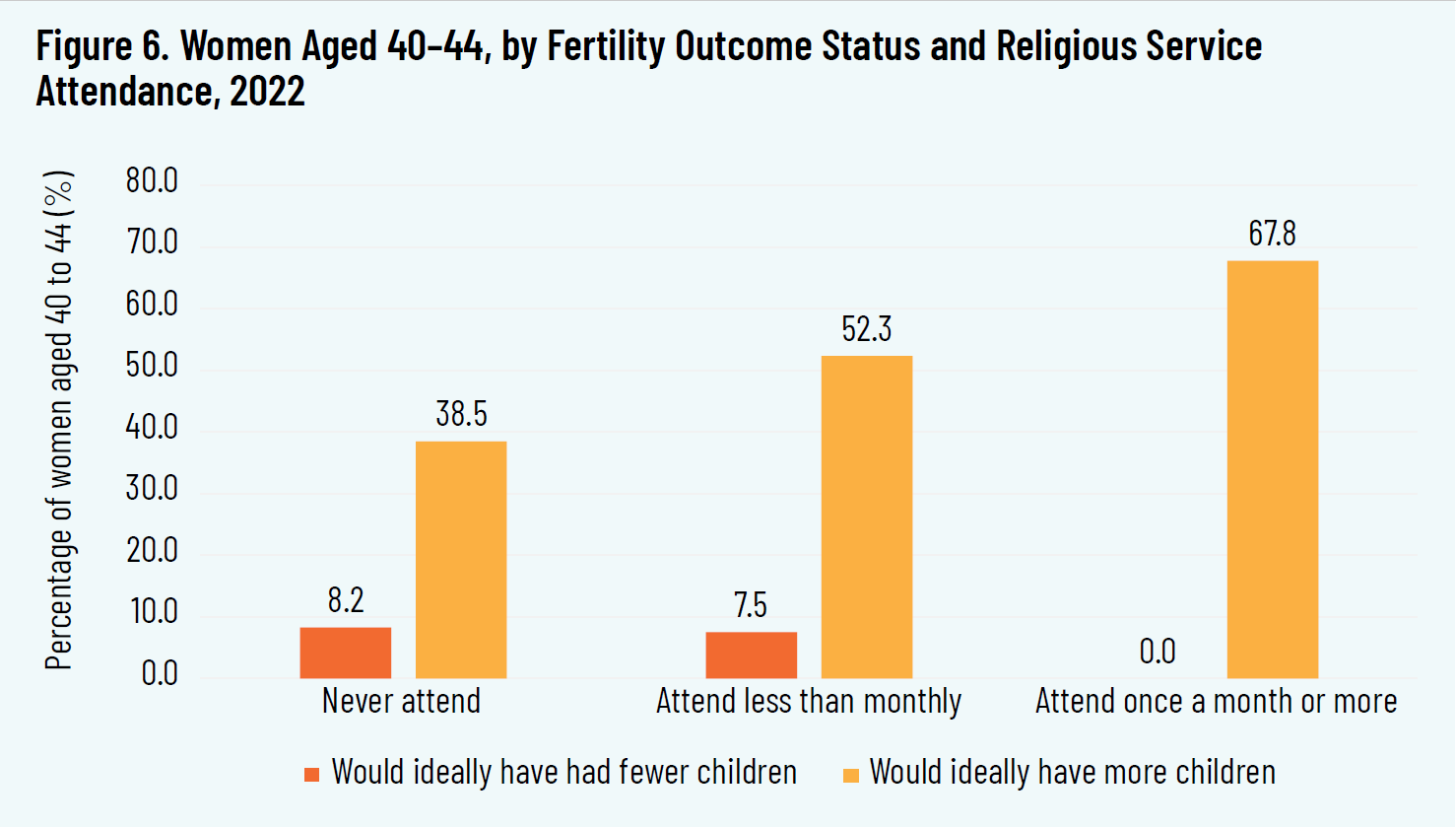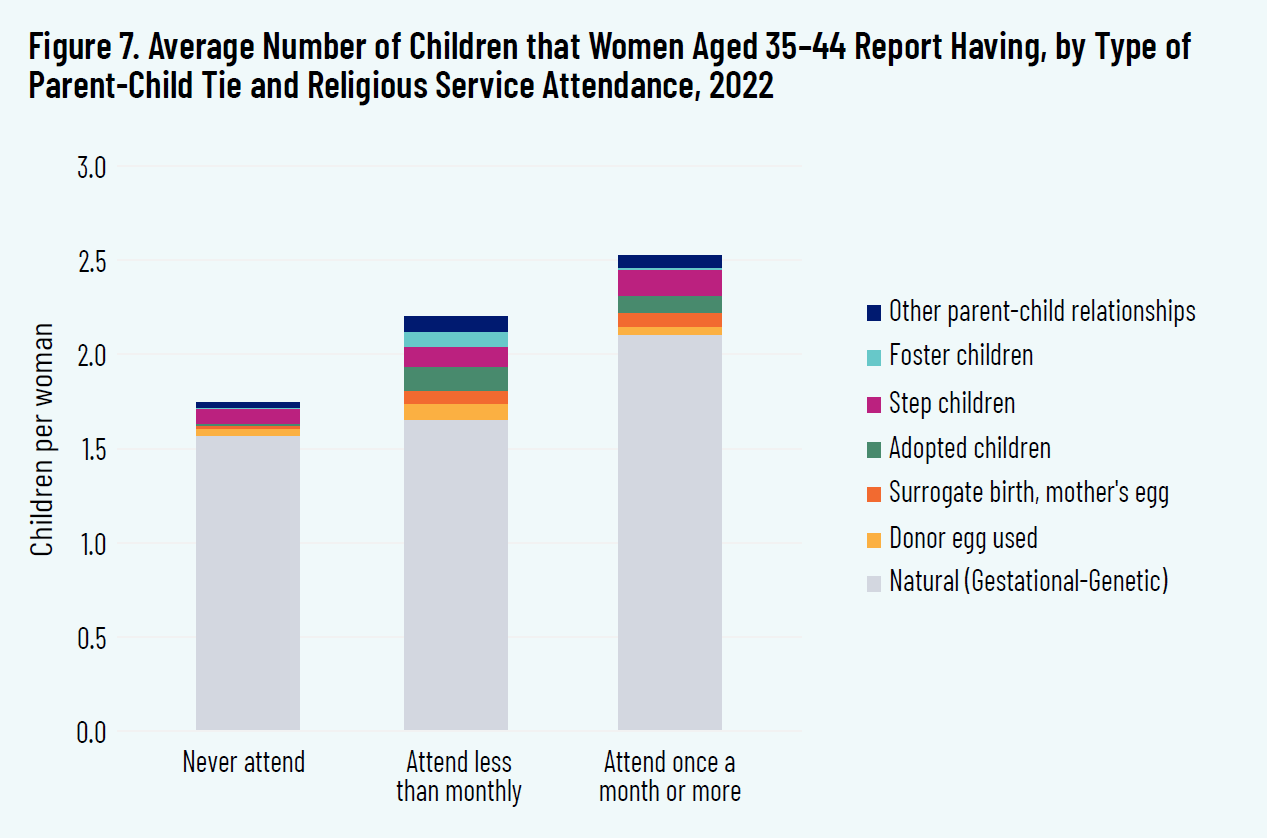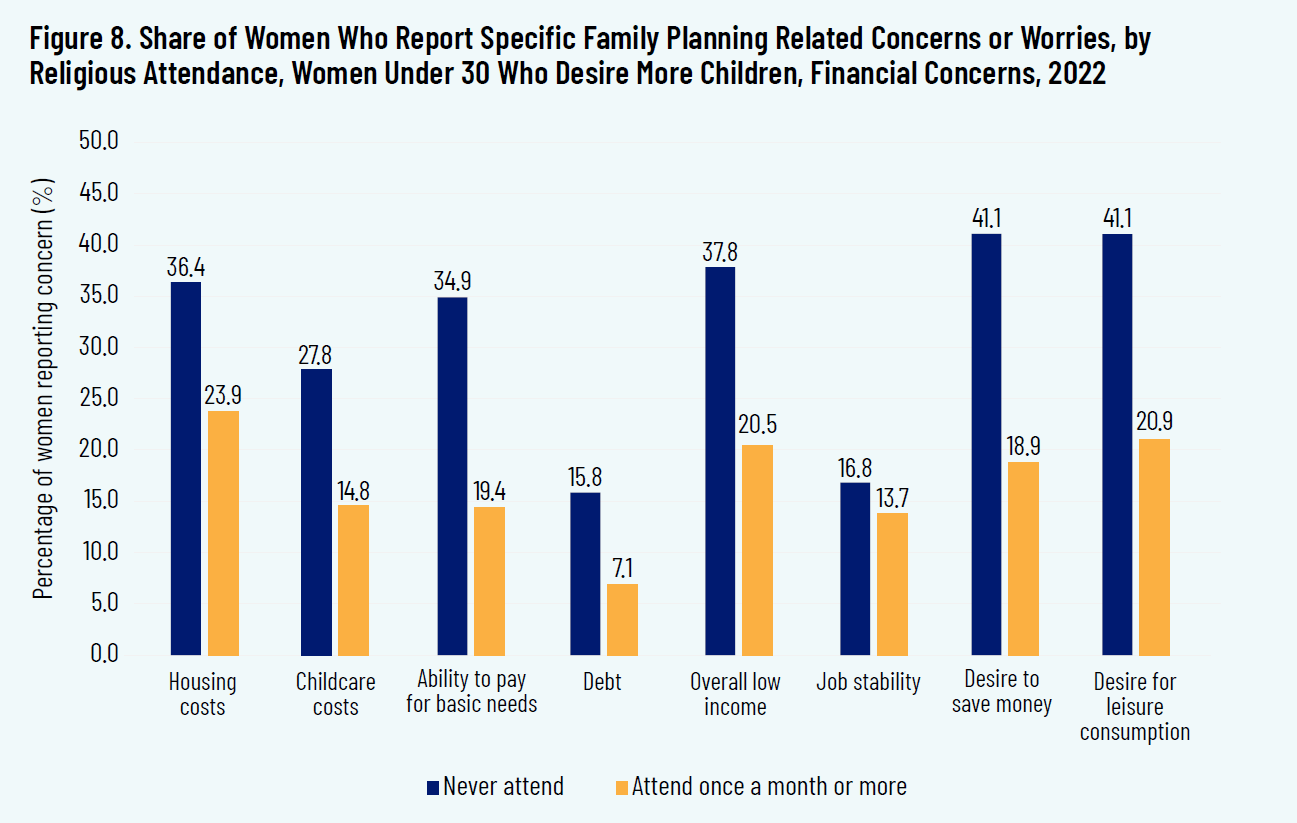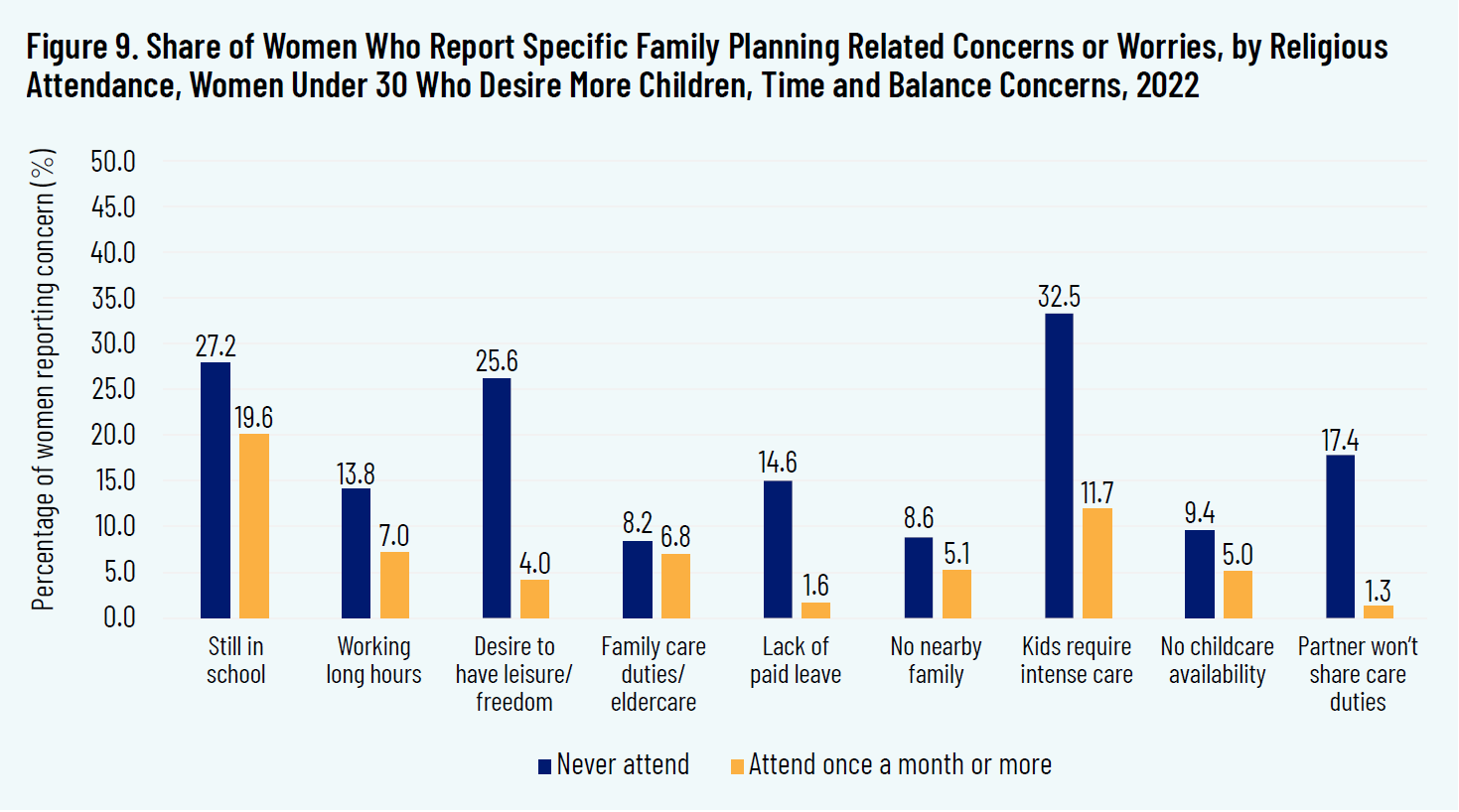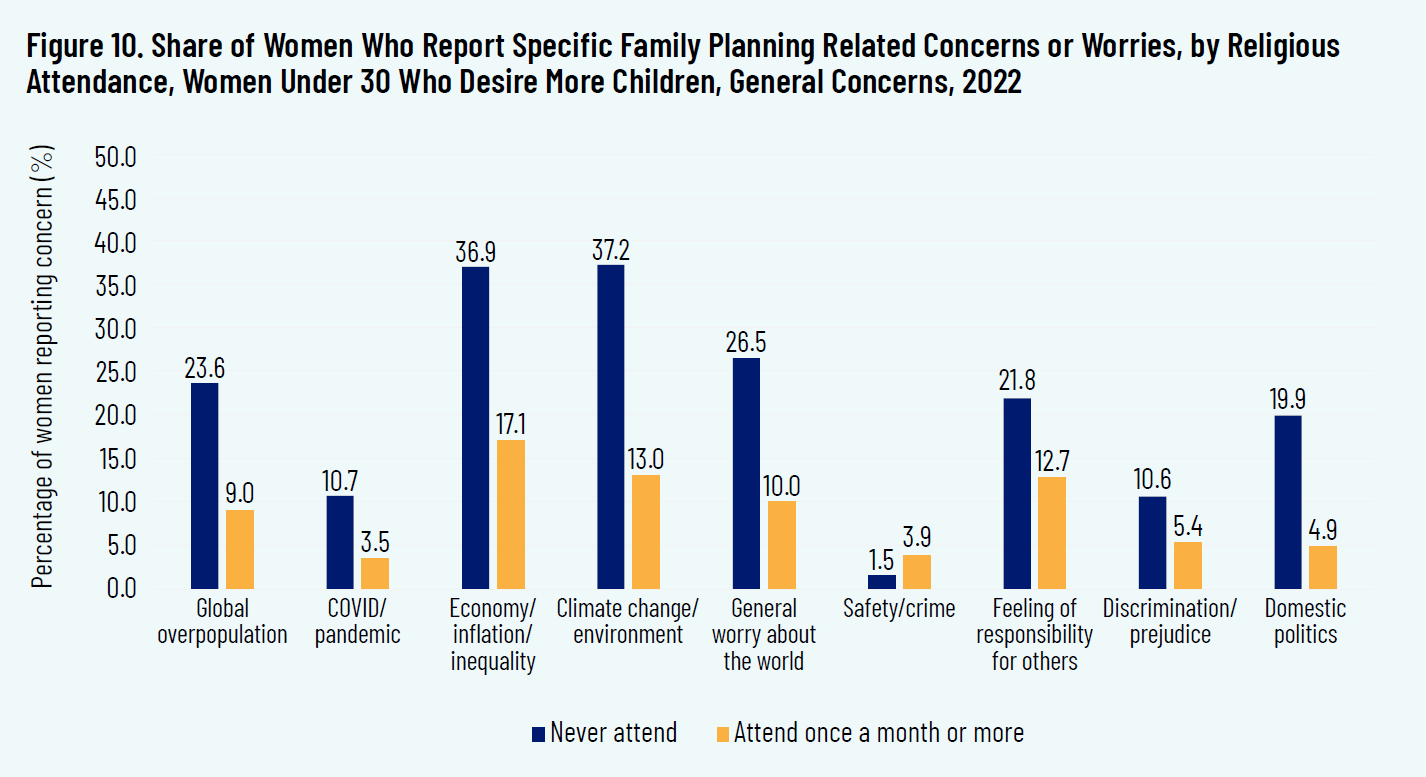Executive Summary
Canadian fertility rates have fallen sharply in recent decades and are now at levels far below what Canadian women say they want. Understanding this reality merits closer inspection. Our earlier paper, “She’s (Not) Having a Baby,” examined why half of Canadian women are falling short of their fertility desires. In this release, we use the same novel survey of 2,700 Canadian women to explore the role that Canada’s changing and diverse religious ecology plays in shaping fertility. This study illuminates to what extent, and through what means, religion influences fertility.
Overall, we find that Canadian women who attend religious services at least monthly desire to have more children, spend more of their life married, and ultimately have more children than nominally religious or nonreligious Canadian women. Contrary to popular narratives, our survey results show no evidence of meaningful differences in women’s employment across different religious groups. In other words, religious women have access to the same economic opportunities as nonreligious women. We take this to mean their higher fertility is not due to a lack of employment among religious women.
Rather, our study suggests that religiously observant women may have more children because their desires for larger families lead them to make different life choices. They marry earlier and thus spend more of their twenties and thirties, when conception is easiest, in married unions. They may benefit from more social support from their families and communities. They also experience less worry and anxiety about a host of different individual and global issues. Indeed, even when religious and nonreligious women have identical financial circumstances, they report dramatically different degrees of financial worries, suggesting that religious women possess additional nonfinancial resources (such as community support or psychological strategies) for managing their situation.
Thus, falling Canadian fertility may be closely related to dwindling religious participation. The rise in the nonreligious population may be one factor driving delayed marriage and increased prevalence of a variety of worries about family formation. As religiosity declines, and as Canada’s religious communities increasingly include a diverse array of faith traditions from around the globe, religious differences in family behaviours will only become a more critical part of understanding Canadian families.
Introduction
Around the world, religious people tend to have more children than other people do. Academics broadly agree that specific religious beliefs, practices, and socializing influence cause differences in fertility behaviour. 1 1 K. McQuillan, “When Does Religion Influence Fertility?,” Population and Development Review 30, no. 1 (2004): 25–56, https://onlinelibrary.wiley.com/doi/10.1111/j.1728-4457.2004.00002.x; T.B. Heaton, “Does Religion Influence Fertility in Developing Countries,” Population Research and Policy Review 30, no. 3 (2011): 449–65, https://doi.org/10.1007/s11113-010-9196-8; T. Baudin, “Religion and Fertility: The French Connection,” Demographic Research 32, no. 13 (2015): 397–420, https://www.jstor.org/stable/26350119; E.L. Lehrer, “Religion as a Determinant of Marital Fertility,” Journal of Population Economics 9, no. 2 (1996): 173–96, https://doi.org/10.1007/s001480050013. This is as true in Canada as it is elsewhere, and yet, the way in which religion influences fertility is not always well understood.
In this report, we use the term “religious” to refer to women who identify as a particular tradition (versus being unaffiliated), or to women who attend religious services at least monthly, because the connection between religion and fertility holds in both cases. This report considers religion and religiosity with a narrower set of criteria that are different from our previous Spectrum of Spirituality research. 2 2 For more on that work, see R. Pennings and J. Los, "The Shifting Landscape of Faith in Canada," Cardus, 2022, https://www.cardus.ca/research/faith-communities/reports/the-shifting-landscape-of-faith-in-canada/.
In Canada today, religion influences fertility on two levels. First, women of a given age who self-identify as religious are more likely to be married than are women who do not. This influence on fertility and family formation occurs especially among the women who attend religious services most frequently, but it occurs to some extent across most levels of religious service attendance. Second, among married women, religious married women tend to have more children than do less-religious married women, both through natural biological conception and through other means, such as adopting and fostering.
Religion’s influence on marriage and family in turn arises from three distinct sources. Religious women (especially those who attend religious services at least monthly) desire larger families, on average. Regularly attending women may also be exposed to doctrinal or belief-based values that offer a high social valuation of married parenthood in particular or that regulate the use of contraception and abortion. Finally, regularly attending women benefit from an extensive range of social supports that buffer against virtually every kind of family-planning worry we surveyed. The outcome of these influences is that religion, and particularly the level of commitment some women may have to religion, overall may nudge women to want more kids, be less worried about various possible obstacles to having kids, and thus end up actually having more kids. If religion is declining in Canada there would then be a correlation with falling fertility.
But it’s not the whole story. We find that even among women who never attend religious services, fertility desires are far in excess of intended or actual fertility rates. Thus, fertility undershooting is a common experience for all groups of Canadian women, regardless of religiosity. About seventy percent of regularly attending women would ideally like to have more children, but across all religious groups, vastly more women undershoot their fertility desires than overshoot them.
Methodology
The data for this report are drawn from a survey that Cardus commissioned with the Angus Reid Group in July 2022. We surveyed 2,700 women in Canada aged 18 to 44 about family and fertility. 3 3 Only respondents who are natal females (that is, who indicated that their sex at birth was female) were included in the survey, as they are the only ones able to gestate children and thus the core population of interest for questions about fertility. Natal female respondents who indicated that they do not identify as women were included in the survey and made up fewer than 2 percent of respondents; as a result, we generally refer to respondents as a group as women. Our sample had three stratified elements: 1,000 native-born women surveyed in English, 1,000 native-born women surveyed in French, and 700 foreign-born women surveyed in French or English. The sample was stratified in this way in order to ensure good coverage of Canada’s diverse society. Respondents were re-weighted to ensure that they are representative of Canadian women on the whole by age, language, income, province, sexual orientation, and household structure (marital status and children). Incidence rates and completion times for native-born Anglophone and Francophone respondents were similar and within normal ranges; incidence rates for foreign-born respondents were low, indicating some difficulty recruiting these respondents. Our earlier report based on this data, “She’s (Not) Having a Baby,” explores family and fertility preferences of women in Canada. 4 4 L. Stone, “She’s (Not) Having a Baby: Why Half of Canadian Women Are Falling Short of Their Fertility Desires,” Cardus, 2023, https://www.cardus.ca/research/family/reports/she-s-not-having-a-baby/.
Due to limited sample sizes of many specific religious traditions, this report amalgamates some religious traditions into clusters of related religious groups. The Angus Reid Group provided survey respondents with a range of possible religious affiliations with which they could identify, including the option of selecting no religious identity and a write-in option. For this report, all write-in responses were recoded to fit within the best-fitting larger amalgamated religious group.
The Angus Reid Group’s pre-defined religious groupings create certain kinds of heterogeneity and obscure other kinds. Thus, for example, respondents were not given the option to identify a specific kind of Protestant Christianity, obscuring what might be important variations or subgroups, such as Evangelical Protestants and mainline Protestants. On the other hand, among people without any affiliation with an organized religion, respondents could identify as atheist, agnostic, “spiritual,” or “nothing in particular.” Because respondents claiming atheism and agnosticism as their religion tend to have similar reported demographic characteristics, fertility preferences, and fertility behaviours, they are grouped together in this report. 5 5 Religions are identifiable value sets that people use for self-identification and social organization, whose meaning is inseparable from a specific disposition toward a metaphysic. As such, both atheism and agnosticism qualify as religious identities or traditions for the purposes of this study. Not all religions are theistic, and scholars of religion have long recognized both transcendent and immanent religions. Thus, for simplicity of reference and because non-religious and secular metaphysical orientations often operate socially as religious identities, we describe these groups as “religions” similar to others. Because “spiritual” and “nothing in particular” respondents did not closely match atheist/agnostic respondents or each other in terms of their observable demographic characteristics and fertility-relevant traits, they were retained as separate groups.
Beyond these consolidations, some groups have been combined for reasons of sample size. Very few Orthodox Christian respondents were identified in the survey, and their responses were similar to those of Catholic respondents; as such, they were grouped with Catholic respondents.
In total, the survey included 981 atheist and agnostic respondents; 603 Catholic and Orthodox Christian respondents; 256 Protestant respondents; 165 “spiritual” respondents; 88 Hindu, Sikh, Buddhist, and other respondents identifying with a religion of Asian origin; 89 Jewish and Muslim respondents; and 542 respondents who said their religion was “nothing in particular.” Respondents were then re-weighted to match the population of Canadian women by province, age, language, income, sexual orientation, and household structure (marital status and children). On the whole, nonreligious respondents were inadvertently oversampled compared to 2021 census estimates for females aged 20 to 45, while most religious traditions (especially Protestants, Sikhs, and Muslims) were undersampled. Because weights were developed to match other sample characteristics and not specifically religion, nonreligious Canadians remain overrepresented, and Sikhs, Muslims, and Catholics remain somewhat underrepresented, in the final weighted sample.
The less-common religions were grouped as described above, for two reasons. The first reason is that initial analysis suggested that Jewish and Muslim respondents had greater demographic similarities to each other than to Hindus or Sikhs, for example. Buddhists and Hindus were more similar to each other than to Jews or Muslims. The second reason is that prior academic research suggests that Abrahamic religions may be unique among world religions in motivating strong pro-natal dispositions. 6 6 V. Skirbekk et al., “Is Buddhism the Low Fertility Religion of Asia?,” Demographic Research 32, no. 1 (2015): 1–28, https://www.demographic-research.org/volumes/vol32/1/32-1.pdf; D. Xie, and Y. Zhou, “Religion Effects on Fertility Preference: Evidence from China,” Journal of Population Research 39, no. 3 (2022): 341–71, https://doi.org/10.1007/s12546-022-09286-4; D. Bessey, “Religion and Fertility in East Asia: Evidence from the East Asian Social Survey,” Pacific Economic Review 23, no. 3 (2017): 517–32, https://onlinelibrary.wiley.com/doi/10.1111/1468-0106.12209.
Jewish, Muslim, Hindu, Buddhist, and Sikh respondents all represented individual groups too small for meaningful independent analysis. Even recoding “Other” respondents who provided answers such as “Vajrayana,” “Shia,” or “Chabad” did not make any of these groups large enough for independent analysis. As such, Jews and Muslims were grouped together as fellow Abrahamic faiths, while Hindus, Sikhs, and Buddhists were grouped together as fellow faiths of South Asian origin. The small number of “Other” respondents who reported Confucian, Chinese, or Daoist religions were also put in the Asian group.
The survey provided respondents with six options for reporting how frequently they attended religious services, ranging from “never” to “once a week or more.” Over half of respondents selected the “never” option, while just 180 respondents selected “once a week or more.” The family traits of those who responded with “once a week or more” or the next most-frequent option, “a few times a month,” were very similar. For most analyses using attendance data, we group “once a week or more” and “a few times a month” together, calling them “regular” attenders. We treat “never” attenders as another separate group, and then we pool respondents who attend more than “never” but less than “a few times a month” as “irregular” attenders.
Religion and Fertility Desires
Canadian women on average report personally desiring to have about 2.2 children and intending to have 1.85, even as Canada’s actual current fertility rate is 1.4 children per woman. 7 7 Stone, “She’s (Not) Having a Baby,” 9. Figure 1 shows that every single religious group in Canada, including atheist and agnostic, reports desiring and intending more than 1.5 children. In other words, fertility undershooting is likely to be the norm for every single religious group, including atheists and agnostics.
Nonetheless, there is important heterogeneity across groups. Atheist women are unique in reporting fertility desires or ideals considerably below two children per woman (in this case, just under 1.9 children). On the other hand, the typical Protestant Canadian woman reports desiring about three children, the highest of any group. This is a large gap between Canadian Protestants and atheist or agnostic women. Among other organized religious groups, the Hindu-Sikh-Buddhist group has the lowest reported fertility desires (under 2.4). This is consistent with academic research suggesting that in many eastern faiths (especially Buddhism), religiosity is not as highly predictive of fertility. (And within India, Sikhs have lower fertility than Hindus, who in turn have lower fertility than Muslims. 8 8 International Institute for Population Sciences and ICF, National Family Health Survey (NFHS-5), 2019–21: India, March 2022, https://dhsprogram.com/pubs/pdf/FR375/FR375.pdf. ) The most widely accepted reason for these differences is that religions vary in their teachings about the spiritual and moral significance of parenthood, work, women’s roles, contraception, and abortion. For instance, when we control for education, visible-minority status, age, relationship status, and reported desire to conceive a child in the near future, we found in our survey that religious women are less likely to report using contraception.
Aside from fertility desires or ideals, we also measured fertility intentions. Intentions varied in similar ways across religious groups but were lower than ideals. Notably, the only groups that report intending to have more than two children on average are Protestant, Catholic, and Eastern Orthodox women. Jewish and Muslim women report intending almost exactly two children, while women in the Hindu-Sikh-Buddhist group report intending a bit less than two, on average, and nonreligious women intend even fewer, especially atheist and agnostic women. As noted in our previous report, “it is very common for women to ‘desire’ children they do not ‘intend,’ because they think those children are unobtainable, for various reasons. Thus, intentions represent a compromise between desires and reality and are almost always lower than ideals or desires.” 9 9 Stone, “She’s (Not) Having a Baby,” 8.
Religious self-identification isn’t all that matters, of course. Some people who identify with a religion may be only nominally attached to it, while for others the religion may be a major source of identity. If we take frequency of attendance at religious services as a proxy for intensity of religious commitment, figure 2 shows that, indeed, women’s desired and intended family sizes rise in relation to frequency of attending religious services.
Frequency of attendance at religious services and religious self-identification can interact in various ways. Figure 3 shows the desired family size for women of each religion, by frequency of religious attendance. As can be seen, regularly attending Catholic and Orthodox Christian women have the largest family-size desires, at almost four children per woman. Among those who never attend religious services, nominal religious affiliation doesn’t matter: pretty much all never-attenders report a desire of about two children.
Strikingly, the Abrahamic faiths (Christianity, Judaism, and Islam) all show the steepest lines. In these faiths, women who attend religious services more frequently have much higher family-size desires. On the other hand, women in the Hindu-Sikh-Buddhist grouping don’t show quite as large an effect of attendance. And among women who don’t identify with any specific religious tradition, more frequent attendance has almost no effect at all.
In sum, both religious identity and frequency of religious attendance matter for family-size desires. Religious identity may shape women’s desires by providing women with particular value sets, attitudes, influences, or moral beliefs about family and fertility. Religious attendance may separately shape women’s desires by providing them with various kinds of social support: childcare, greater community, or other resources, or by intensifying their exposure to the values and attitudes associated with a religious identity.
Marriage, Religion, and Family Outcomes
Women who attend religious services more frequently want more children and have more family-oriented dispositions, and in turn they have actually higher fertility rates. One key reason is that regularly attending women are more likely to marry, and research shows that even in industrialized societies such as Canada in which many children are born to unmarried mothers, marriage leads to larger family size. 10 10 L. Stone and S. James, “For Fertility, Marriage Still Matters,” Institute for Family Studies, October 6, 2022, https://ifstudies.org/blog/new-report-for-fertility-marriage-still-matters. Figure 4 shows the share of women in our survey who are in a married union, by age and religious service attendance.
At every age, women who attend religious services more frequently are more likely to be married. Accounting for sampling error, regularly attending women in their late twenties are 15 to 65 percentage points more likely to be married than never-attending women. Even in their early forties, the gap is 6 to 29 percentage points. This very large gap in marital status across levels of religious attendance exerts an enormous influence on fertility, as can be seen in figure 5, which shows the number of children ever born, by women’s age and religious service attendance.
Women who regularly attend religious services report having considerably more children through their thirties than do women in the same age cohort who attend services less frequently. For women in their forties, differences are trivial, but this is probably a generational effect; it is not possible that women who are 35 to 39 today could see their children ever born decrease in the next five years. In all likelihood, religious women in their thirties today have more children than their peers did a decade ago. While figure 5 presents data for all women, it should be noted that among women who have ever been married, the gap in children ever born is smaller: one reason that women who regularly attend religious services have more children is that they spend more of their lives married, as indicated in figure 4. But even among married women, regular attenders have more children—as would be expected, since women who more often attend religious services desire more children.
For every group of women, however, undershooting fertility is more common than overshooting; that is, “missing” children are more common than “excess” children. Figure 6 shows the share of women in their forties at each level of religious service attendance who had more versus fewer children than they say is ideal for them personally.
Women who regularly attend religious services want more children and so are more likely to have gaps between their fertility desires and their final family size. But even among women who never attend religious services, about 40 percent report having fewer children than they say would be ideal for them. Among women who are regular attenders, the figure is nearly 70 percent.
Of course, not all of these women in their early forties have finished having kids. Among women in their early forties who never attend religious services, fewer than 1 percent intend to have more kids. Among irregularly attending women in the same age cohort, the figure is around 6 percent, and among the most frequently attending women, it is 13 percent. Thus, by the time they reach their fifties, some of the most frequently attending women will have achieved their desired fertility, while the figures for never-attending women are less likely to change much, causing some convergence in undershooting rates.
Finally, family formation isn’t only about biological children; it also includes adopted, step, and foster children. Figure 7 shows not the average number of children born to each woman by frequency of religious service attendance, but the average number of persons that women in each group consider to be their children, broken out by whether they are biological, foster, adopted, surrogate, or some other kind of parent-child relationship.
On average, regularly attending women have a higher number of natural biological children (that is, children gestated by a woman from her own eggs). But they also have more of other kinds of children than nonreligious women: more births from donor eggs, more births to surrogate mothers using their eggs, more adopted children with no genetic or gestational ties, more stepchildren, more foster children, and more unspecified other kinds of parent-child ties. In fact, while the gap in natural biological children between regularly attending and never-attending women is about 0.5 children per woman, the gap grows to about 0.75 children per woman when considering all kinds of children. This is true despite the fact that some religious women have moral objections to some kinds of assisted-reproductive technology, to some forms of surrogacy, and to the divorces or remarriages that may generate stepchildren. Thus, women who attend religious services not only have more children than nonreligious women, but they also tend to acquire parent-child ties from more different sources than nonreligious women.
Religion and Family Worries
Many religions supply women with values and attitudes that encourage marriage, motivate higher family-size desires, and support family formation, as we stated earlier. But still, the exact dynamics involved in this process can be hard to pin down. How exactly does religion have these effects?
For this question, we turn to the survey questions we asked about worries affecting family planning. As in the earlier report from this survey data, these worries predict a much lower likelihood of women intending to have more children, even if they want children. 11 11 See Stone, “She’s (Not) Having a Baby,” 19–24. The worries that we surveyed included housing costs, the difficulty of parenting, lack of a suitable partner, concerns about personal development, and other topics. Because the worries that we surveyed are extremely predictive of lower fertility intentions, it is reasonable to ask if frequency of religious service attendance is related to fertility-related worries. We find that it is.
Figures 8 through 11 show the share of women who reported having a given worry, issue, or concern, among women under 30 who desire more children based on their reported family ideals. This group was assessed because they are just beginning family formation and few are experiencing age-related infertility, and thus these kinds of conscious concerns and worries may be most influential for them. For example, in our earlier report, we found that the single most powerful concern in terms of reducing the likelihood of having another child in the next two years was a woman’s agreement with the phrase, “I’m still exploring myself and want to develop as a person before I become a parent.” Among women under 30 who desire additional children, 48 percent of never-attending women report this concern, versus just 19 percent of regularly attending women, for a difference of 29 percent. Correspondingly, in figure 11, this worry, summarized as “Want to grow as a person,” is shown as 48 and 19 percent for never-attending and regularly attending women, respectively.
Never-attending women under age 30 are more likely to report being concerned about every single worry, issue, or concern, other than those about personal safety and crime. When never-attending and regularly attending women look at the world and their family aspirations, never-attending women simply see a much more worrisome picture. Some of this could be political differences: never-attending women are much more worried about climate change, for example, and these women might argue that more politically conservative religious women are ignoring a very real problem that will harm their children later in life. We will explore this topic in greater depth in a future report. But many reasons surveyed have little to do with politics, and in some cases it is possible to demonstrate that nonreligious and religious women in similar material circumstances actually have very different assessments of concerns and issues.
For example, one might assume that women’s financial concerns, shown in figure 8, are closely related to their financial situation—that women with more precarious financial situations would have more financial worries. However, the survey also measured women’s financial situations, by asking about household income, recent positive or negative changes to household finances, and respondents’ subjective assessment about their ability to pay for household expenses. Each of these variables is indeed predictive of financial worries, both independently and considered all together. Yet, controlling for all these financial factors, never-attending women under age 30 report more than twice as much financial concern as an obstacle to childbearing as regularly attending women. In short, even when regularly attending and never-attending women report similar or identical objective and subjective financial status, never-attending women are more likely to say that financial concerns prevent them from having children.
There are at least two possible explanations here. The first is that regularly attending women may benefit from higher levels of non-financial support. Academic research has shown that religious women get more help with childrearing from family members and friends, and in particular from their religious communities. 12 12 J.H. Shaver et al., “Alloparenting and Religious Fertility: A Test of the Religious Alloparenting Hypothesis,” Evolution and Human Behavior 40, no. 3 (2019): 315–24, https://doi.org/10.1016/j.evolhumbehav.2019.01.004. Thus, it may be that even when religious and nonreligious women have similar financial situations, their overall level of material resources still differ in important ways due to nonfinancial resources. This may be part of the explanation for the gap, but perhaps not all, since regularly attending and never-attending women have very small gaps in reported worries about other family-care duties, lack of a partner, or lack of nearby family. At least in terms of women’s conscious worries, regularly attending and never-attending women are similar in their judgements of kin support, with the exception that never-attending women are much more concerned that their partners will not share childcare responsibilities. It may be that women who regularly attend religious services are more likely to have partners who want to be involved parents, whereas women who never attend are more likely to have partners who are less engaged at home, though large differences in this area would be somewhat surprising. 13 13 W. Bradford Wilcox, Soft Patriarchs, New Men: How Christianity Shapes Fathers and Husbands (Chicago: University of Chicago Press, 2004).
The second major explanation for why regularly attending and never-attending women with similar circumstances might report dramatically different levels of worry in their family planning is that religion might itself serve as a psychological buffer against anxiety. Prior academic research has shown that religion protects against a range of mental and behavioural health conditions. 14 14 M. Dilmaghani, “Religiosity and Subjective Wellbeing in Canada,” Journal of Happiness Studies 19, no. 3 (2018): 629–47, https://doi.org/10.1007/s10902-016-9837-7; C.G. Ellison, “Religious Involvement and Subjective Well-Being,” Journal of Health and Social Behavior 32, no. 1 (1991): 80–99, https://doi.org/10.2307/2136801; J.M. Mellor and B.A. Freeborn, “Religious Participation and Risky Health Behaviors Among Adolescents,” Health Economics 20, no. 10 (2010): 1226–40, https://doi.org/10.1002/hec.1666; A.Y. Evrensel, “Contradictory Effects of Religiosity on Subjective Well-being,” Cogent Economics & Finance 6, no. 1 (2018): 1–26, https://doi.org/10.1080/23322039.2018.1525115; J.W. Sinha, R.A. Cnaan, and R.J. Gelles, “Adolescent Risk Behaviors and Religion: Findings from a National Study,” Journal of Adolescence 30, no. 2 (2007): 231–49, https://doi.org/10.1016/j.adolescence.2006.02.005. It is possible that religious beliefs and dispositions give women useful cognitive or psycho-emotional strategies for managing normal life stressors and episodic crises. As a result, religious women facing similar objective stressors may experience less durable and severe anxiety because their religious beliefs provide efficient coping strategies. If religion specifically buffers women’s affective states related to family planning, this could explain why women who attend services more frequently have more children: they might carry a lighter psychological load for any given level of objective difficulty in life.
Conclusion
Canadian women are having fewer children than they report desiring, on average. This is true across every religious grouping in Canada, and in fact, among women in their forties, “missing” children outnumber “excess” ones at each level of religious service attendance. While our survey shows that religious women have a larger gap between desired and actual fertility, meaningful gaps exist for all groups.
Religion’s role in shaping fertility is complex and includes multiple elements. Intensity of religious commitment, as measured by religious service attendance, predicts higher desired and actual fertility in general and within most specific religious traditions. Not all religious groups are the same, however: fertility desires rise more steeply with attendance for some groups, especially the Abrahamic faiths. Thus, both religious service attendance and religious self-identification independently matter for family formation.
Aside from differences in fertility motivations (intentions), religiosity may influence fertility by first influencing marriage. At every age, we find that religious women are likelier to be married. Since marriage remains a very strong predictor of fertility outcomes in academic literature and in our data, religion’s effect in motivating and facilitating earlier and more marriage in turn influences fertility.
But religious families are not open only to biological children. We find that more-religious women also have more non-biological (adoptive, foster, step) children and that they also use more of some forms of reproductive technology than nonreligious women. Thus, the religious difference in family is not limited to genetic family but manifests in a broader openness to many kinds of parent-child relationships, especially adoption.
Finally, religiosity is strongly associated with a lower likelihood of concerns, of the type women face when they contemplate having children. Religious women report less worry across almost every single category related to family planning that we surveyed. This difference is not caused simply by differences in socioeconomic factors: similarly situated religious women report much lower incidence of worries and concerns than do nonreligious women. It is likely that religious women benefit from more support from families, communities, and possibly even spouses than do nonreligious women. But it is also possible that religion affords women with particular strategies for psychological resilience. Faced with an often-uncertain world that presents numerous obstacles to childbearing, religious women do not perceive themselves to be as burdened by anxieties and cares related to family formation, suggesting that religiosity remains an invaluable source of psychological and emotional capital in Canada today.
References
Baudin, T. “Religion and Fertility: The French Connection.” Demographic Research 32, no. 13 (2015): 397–420. https://www.jstor.org/stable/26350119.
Bessey, D. “Religion and Fertility in East Asia: Evidence from the East Asian Social Survey.” Pacific Economic Review 23, no. 3 (2017): 517–32. https://onlinelibrary.wiley.com/doi/10.1111/1468-0106.12209.
Bradford Wilcox, W. Soft Patriarchs, New Men: How Christianity Shapes Fathers and Husbands. Chicago: University of Chicago Press, 2004.
Dilmaghani, M. “Religiosity and Subjective Wellbeing in Canada.” Journal of Happiness Studies 19, no. 3 (2018): 629–47. https://doi.org/10.1007/s10902-016-9837-7.
Ellison, C.G. “Religious Involvement and Subjective Well-Being.” Journal of Health and Social Behavior 32, no. 1 (1991): 80–99. https://doi.org/10.2307/2136801.
Evrensel, A.Y. “Contradictory Effects of Religiosity on Subjective Well-being.” Cogent Economics & Finance 6, no. 1 (2018): 1–26. https://doi.org/10.1080/23322039.2018.1525115.
Heaton, T.B. “Does Religion Influence Fertility in Developing Countries.” Population Research and Policy Review 30, no. 3 (2011): 449–65. https://doi.org/10.1007/s11113-010-9196-8.
International Institute for Population Sciences and ICF. National Family Health Survey (NFHS-5), 2019–21: India. March 2022. https://dhsprogram.com/pubs/pdf/FR375/FR375.pdf.
Lehrer, E.L. “Religion as a Determinant of Marital Fertility.” Journal of Population Economics 9, no. 2 (1996): 173–96, https://doi.org/10.1007/s001480050013.
McQuillan, K. “When Does Religion Influence Fertility?” Population and Development Review 30, no. 1 (2004): 25–56. https://onlinelibrary.wiley.com/doi/10.1111/j.1728-4457.2004.00002.x.
Mellor, J.M., and B.A. Freeborn. “Religious Participation and Risky Health Behaviors Among Adolescents.” Health Economics 20, no. 10 (2010): 1226–40. https://doi.org/10.1002/hec.1666.
Pennings, R., and J. Los. “The Shifting Landscape of Faith in Canada.” Cardus, 2022. https://www.cardus.ca/research/faith-communities/reports/the-shifting-landscape-of-faith-in-canada/.
Shaver, J.H., C.G. Sibley, R. Sosis, D. Galbraith, and J. Bulbulia. “Alloparenting and Religious Fertility: A Test of the Religious Alloparenting Hypothesis.” Evolution and Human Behavior 40, no. 3 (2019): 315–24. https://doi.org/10.1016/j.evolhumbehav.2019.01.004.
Sinha, J.W., R.A. Cnaan, and R.J. Gelles. “Adolescent Risk Behaviors and Religion: Findings from a National Study.” Journal of Adolescence 30, no. 2 (2007): 231–49. https://doi.org/10.1016/j.adolescence.2006.02.005.
Skirbekk, V., M. Stonawski, S. Fukuda, T. Spoorenberg, C. Hackett, and R. Muttarak. “Is Buddhism the Low Fertility Religion of Asia?” Demographic Research 32, no. 1 (2015): 1–28. https://www.demographic-research.org/volumes/vol32/1/32-1.pdf.
Stone, L. “She’s (Not) Having a Baby: Why Half of Canadian Women are Falling Short of Their Fertility Desires.” Cardus, 2023. https://www.cardus.ca/research/family/reports/she-s-not-having-a-baby/.
Stone, L., and S. James. “For Fertility, Marriage Still Matters.” Institute for Family Studies, October 6, 2022, https://ifstudies.org/blog/new-report-for-fertility-marriage-still-matters.
Xie, D., and Y. Zhou. “Religion Effects on Fertility Preference: Evidence from China.” Journal of Population Research 39, no. 3 (2022): 341–71. https://doi.org/10.1007/s12546-022-09286-4.


